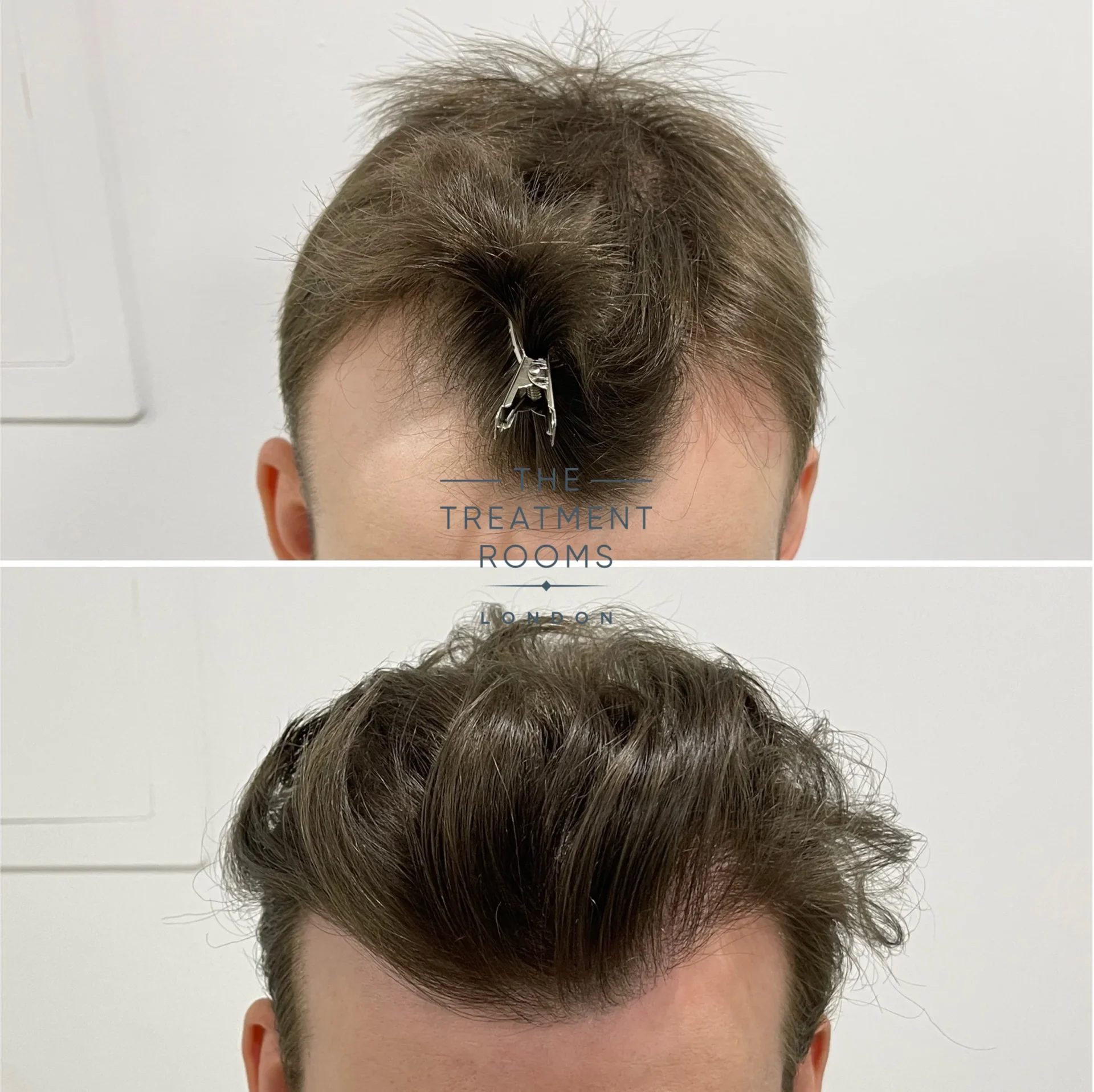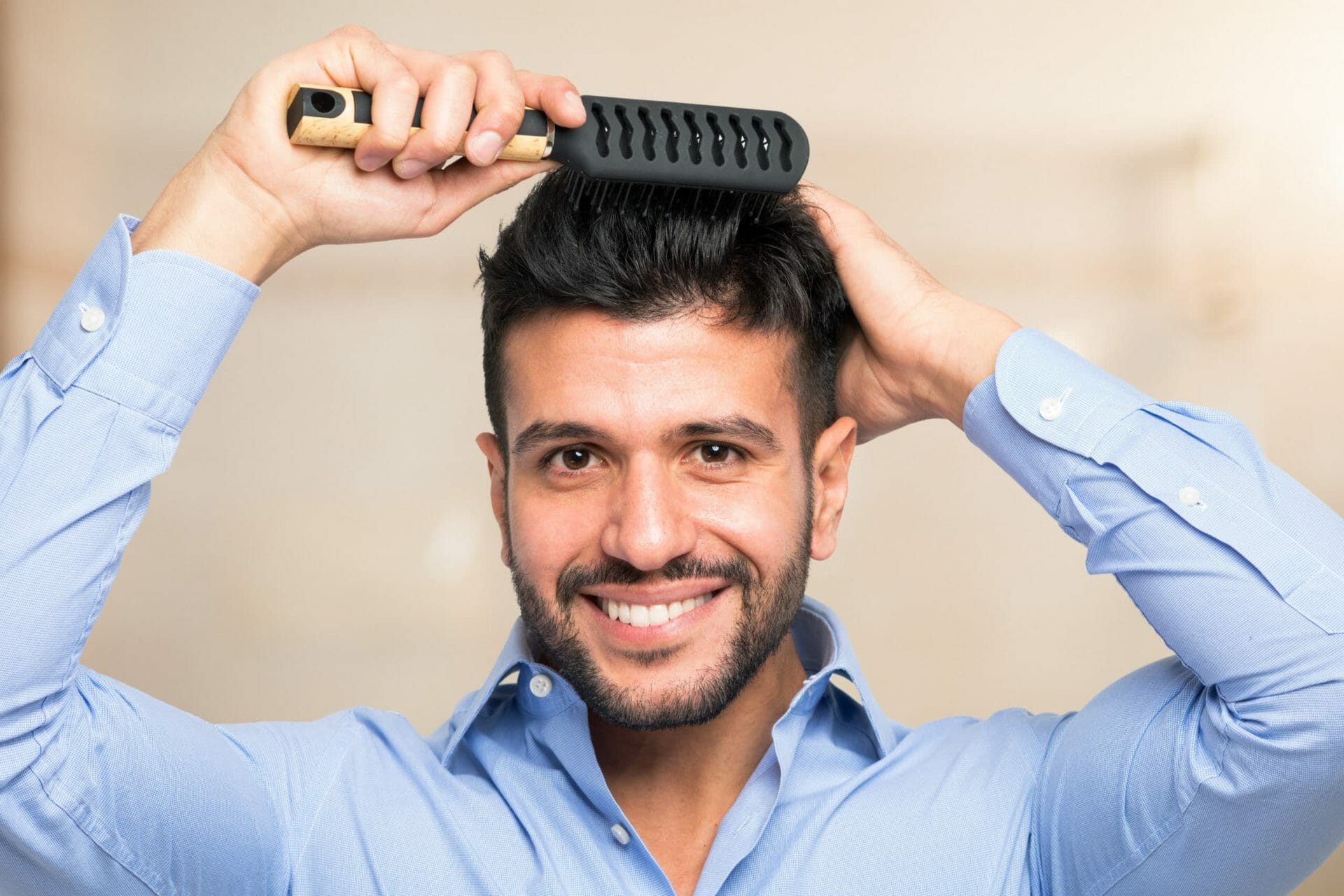You should not feel pain during your hair transplant after your scalp has been numbed using local anaesthesia. At The Treatment Rooms London we also provide light sedation for extra comfort. This means an FUT or an FUE hair transplant is a comfortable process for most patients, a procedure which takes between 6-8 hours to complete. Despite most patients being very anxious about potential pain, here at The Treatment Rooms London, we make every effort to ensure they are kept as comfortable as possible. In this blog you can find out more about whether having a hair transplant is painful.
Pain Management During A Hair Transplant
In the scalp there are many nerves so these must be anaesthetised (blocked from working) so that when our Surgeons perform hair transplant surgery, their patient does not feel any pain whatsoever. Our Surgeons perform this using different techniques:
- Using local anaesthetic injections
- Giving pain relieving medications
- Giving light sedation so the patient feels sleepy, comfortable and relaxed during the procedure
Local Anaesthesia Injections
The primary technique your Surgeon will use to numb your scalp is local anaesthesia injections. These are tiny injections into the areas where your surgeon will remove hair and implant it, such as the hairline, temples, or crown. The injections are performed using an extremely fine needle (nearly the width of a human hair).
Even though the needle is very small, our Surgeons go the extra mile. They use a TENS device on your skin to distract your brain from receiving all the pain signals. This means that any soreness from the initial numbing injections is significantly reduced. After this stage is finished, your entire scalp will be numb, and you shouldn’t feel pain during the procedure.
Giving Pain-Relieving Medications
In addition to local anaesthetic, our Surgeons will also provide you with some pain-relieving medications. These help reduce any discomfort throughout the procedure and further relax you.
Techniques used to minimise discomfort
Being stressed increases your brain’s perception of pain. So keeping every patient friendly and relaxed is one of our main priorities. Our custom-built hair transplant clinic is designed to keep every patient relaxed. We use different techniques such as:
- Giving a tablet that makes you feel sleepy and relaxed
- Music
- Temperature Control
This means that whilst patients are undergoing surgery, they often feel so comfortable they fall asleep. If you’d like to learn more about undergoing a hair transplant at The Treatment Rooms London, watch the video below!
Is It Painful During Hair Transplant Surgery?
During the hair transplant, you should not feel pain following your initial local anaesthetic injections. Once the procedure starts, you will feel the hair transplant surgeon’s light touch on your scalp. Together with calming music, you may find you fall asleep.
If you stay awake during the procedure, you are kept as comfortable as possible with your choice of entertainment. This includes music, podcasts, TV shows, films, and more.
By choosing to have your hair transplant at The Treatment Rooms London, you can expect the highest attention when it comes to your comfort. We take pride in making sure the process is as relaxing as possible. One of our patients has even described having surgery at The Treatment Rooms London as:
“It’s like sitting in a First Class plane seat and having a hair transplant“

Pain After FUE Hair Transplantation
After your hair transplant, you will be given a recovery pack and instructions. Any pain you may feel will be easily managed with simple painkillers such as:
- Paracetamol
- Ibuprofen
- Co-codamol if required
After surgery, most patients are pain-free and don’t require any further medications.
Our Surgeons will keep in contact with you regularly following your surgery. This means your recovery should go to plan, and if needed, you will have access to our specialist advice with our dedicated caretaker service.
Pain After FUT Hair Transplantation
After your FUT hair transplant, you may feel some pain in your donor site. This is a common occurrence and tends to worsen in the first two weeks post-procedure. At The Treatment Rooms London, we will provide you with codeine based medication to help alleviate this pain. As a side effect, this medication can make you feel itchy and can also make you feel constipated. If you experience issues with this tablet, please notify your surgeon.
Will pain affect my transplant?
Pain should not affect your hair transplant. If you have pain lasting longer than 28 days, you should contact your surgeon at your hair transplant clinic, who will want to assess you further.
If you are interested in undergoing a hair transplant at The Treatment Rooms London, learn more and book your consultation today.
Post hair transplant sensations and care.
After surgery, it is normal for your scalp to feel numb in certain areas and sensitive in others. We find these abnormal sensations can last a few weeks before returning to normal. Sometimes, we recommend specific lotions to apply to the scalp to alleviate discomfort, especially if patients experience pain at night while lying on their donor area. Most of our patients should be able to return to work after hair transplant within 10 days.
Book a Consultation at The Treatment Rooms London
One of the most common questions we are asked by our male, female and transgender patients is whether having a hair transplant is painful. We can reassure patients during their one-on-one consultation with a Surgeon about the process of surgery and how we go to great lengths to ensure patients are comfortable during the procedure.
If you want to understand more about the procedure and how we can help you with your hair loss, don’t hesitate to get in touch with our hair transplant clinic today.
Hair Transplant and Age FAQs
1. What is the ideal age range for a hair transplant?
Most surgeons recommend waiting until your mid-20s at the earliest, when patterns of hair loss have become more established and predictable. Between the ages of 25 and 65 is generally considered optimal: younger than 25, hair loss may not yet be stable; older than 65, skin laxity and health factors can affect healing and graft survival. Ultimately, candidacy is based on an individual’s hair-loss pattern, donor supply, and overall health, rather than strict age limits.
2. Is a hair transplant painful during the procedure?
Most patients report minimal pain during the transplant itself because the scalp is numbed with local anaesthesia. You may feel pressure, mild tugging, or a slight vibration from the instruments, but not sharp pain.
3. Can I get a hair transplant before I turn 30?
Yes, but only if your hair loss pattern is well-established and you have sufficient donor hair. Under 30, you risk continued progression of baldness that can create gaps between transplanted and native hair. If you’re under 30, many surgeons will insist on at least a year of medical therapy (e.g., finasteride, minoxidil) to confirm stability before proceeding.
4. Why must hair loss be stabilised before surgery?
Stabilising hair loss ensures that:
- Grafts last: Preventing ongoing miniaturisation around the transplant zones preserves your results.
- Natural appearance: If loss continues, untreated areas may recede, leaving transplanted islands of hair.
- Efficient use of donor supply: You’ll make the best use of limited donor follicles rather than wasting grafts on areas that later miniaturise.
5. What non-surgical treatments help stabilise hair loss?
Standard non-surgical options include:
- Finasteride (oral): Inhibits DHT, slowing or halting male-pattern loss.
- Minoxidil (topical): Increases blood flow to follicles, promoting thicker growth.
- Platelet-Rich Plasma (PRP): Injected growth factors can strengthen follicles.
- Low-Level Laser Therapy (LLLT): Light therapy that may improve follicle health.
Combining therapies often yields the best stabilisation.
6. What happens during an FUE hair transplant?
- Consultation & planning: Design hairline, assess donor density.
- Preparation: Shave or trim the donor area; apply local anaesthesia.
- Extraction (FUE): Individual follicular units are harvested with a micro-punch (0.7–1.0 mm).
- Recipient site creation: Tiny incisions are made in the thinning area, following the planned angle and density.
- Graft placement: Extracted follicles are meticulously inserted into recipient slits.
- Recovery: Mild swelling/scabbing; most patients return to routine activities within a week.
7. Can older patients—or those with grey hair- still undergo a transplant?
Absolutely. Age alone isn’t a barrier if you’re in good health with an adequate donor supply. Grey or white hair can help camouflage scalp visibility due to its lighter colour, sometimes producing a fuller visual effect. Older patients should discuss skin elasticity and healing capacity with their surgeon, but there’s no strict upper age limit.
8. Does the anaesthesia used in a hair transplant hurt?
The initial injections of local anaesthesia can sting briefly, similar to a pinprick. Surgeons often use a fine-gauge needle and inject slowly, which significantly reduces discomfort. After the area is numb, you won’t feel further injections or the procedure.
9. What level of discomfort can I expect in the week following a hair transplant?
In the first 2–3 days, you may experience:
- Mild soreness or tightness in the graft and donor areas
- Swelling around the forehead and temples, tiny scabs around the grafts
Most patients manage this with over-the-counter pain relievers (e.g., acetaminophen or ibuprofen) and feel comfortable returning to light activities within 2–4 days. Any discomfort typically subsides by day 7–10.
10. Is PRP treatment after a hair transplant painful
PRP (Platelet-Rich Plasma) involves drawing blood from the patient and injecting it into the scalp. The injections can cause mild pinching or pressure, but are generally well tolerated. Many clinics apply a topical numbing cream beforehand to minimise any pain.
References
3) Teoli and An, 2019. Transcutaneous Electrical Nerve Stimulation (TENS)
Share:
Authored by
Reviewed by
Book a Consultation
Related Blogs
Which Medications Cause Hair Loss?
August 20, 2025
Medicines are essential in treating diseases, enhancing health, and even saving lives. While medicines can be very…
Does Vitamin C Deficiency Cause Hair Loss? Causes, Evidence & Nutrition Guide
August 20, 2025
Vitamin C, also known as ‘ascorbic acid’, is one of many critical water-soluble vitamins that play various…
Can Dry Shampoo Cause Hair Loss? Risks, Research & Safe Use
August 20, 2025
Dry shampoo is a time-saving staple for oily roots and no-wash days, but does this convenience come…
Does Saw Palmetto Work for Hair Loss? Evidence, Benefits and Side Effects
August 18, 2025
Male pattern or female pattern baldness, scientifically known as androgenetic alopecia (AGA), is a type of hair…
How Many Hair Grafts Do You Need For A FUE Hair Transplant?
August 8, 2025
A Follicular Unit Excision (FUE) or FUT hair transplant is one of the two main procedures available to address…
Do Hats Cause Hair Loss? Debunking Myths & Understanding the Facts
August 1, 2025
Hats have been a global trend to wear, whether for style, warmth, or sun protection. But have…
What Causes Hair Loss During Menopause?
July 30, 2025
For many women, hair is an expression of identity, personality and self-image. During menopause, the body undergoes…
Can Hair Brushing Stimulate Hair Growth?
July 30, 2025
Quick Summary: Hair Brushing and Hair Growth Brushing’s Real Benefits: While brushing doesn’t directly stimulate hair growth,…
Best Post-Hair Transplant Medication for Effective Recovery and Growth
July 15, 2025
Hair transplant surgery has become one of the most effective and reliable methods for physically reversing hair…











